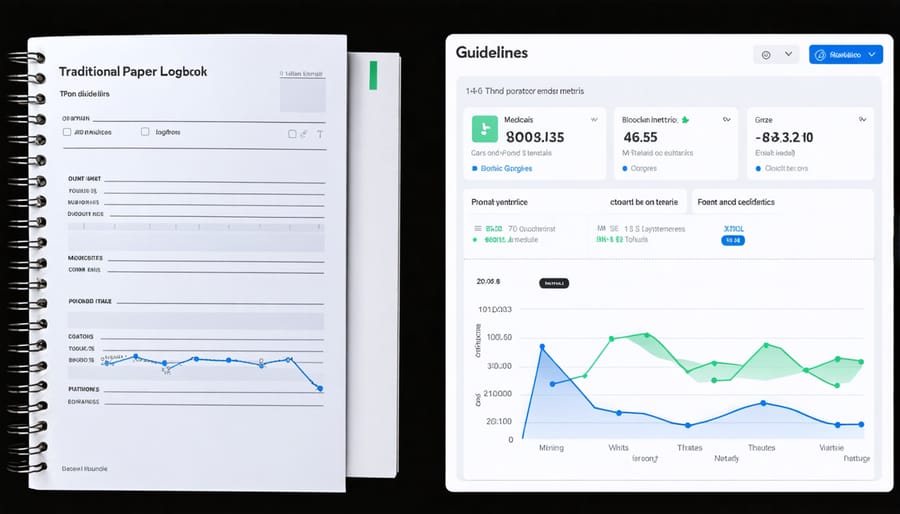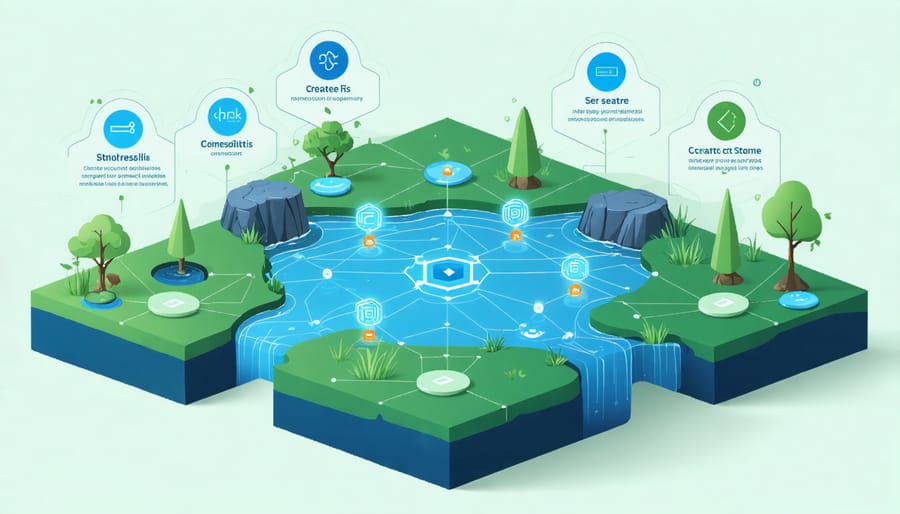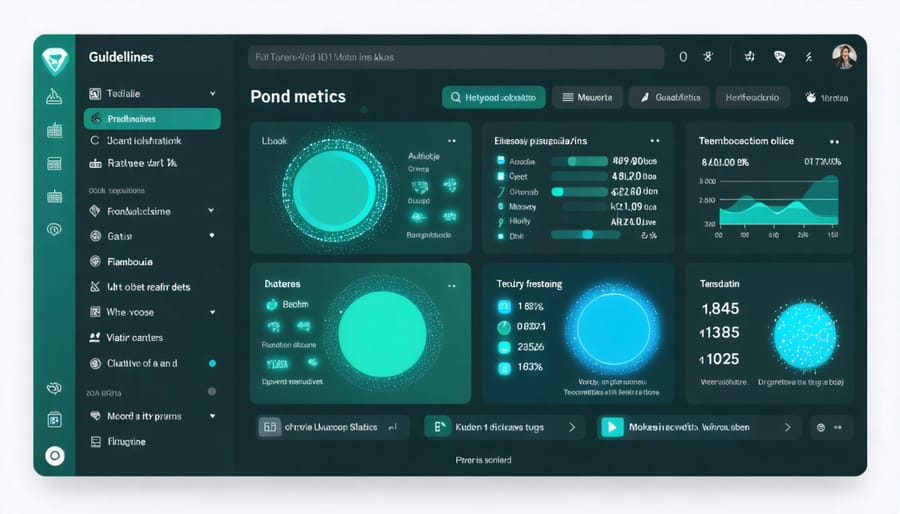
Secure Your Pond’s Future: How Blockchain Protects Your Water Garden Investment
Blockchain technology is revolutionizing risk management in ways that pond owners and water garden enthusiasts can immediately put to practical use. By creating an immutable digital record of water quality measurements, maintenance schedules, and equipment performance, blockchain provides unprecedented transparency and reliability in pond management operations.
Think of blockchain as a digital ledger that permanently records every water test result, filter cleaning, and chemical treatment you perform. Unlike traditional paper logs or basic software, these records cannot be altered or lost, giving you complete confidence in your pond’s historical data. This becomes invaluable when troubleshooting issues or proving compliance with local regulations.
For pond owners who collaborate with multiple service providers or manage multiple water features, blockchain’s smart contracts automatically trigger maintenance alerts and verify completed work. This eliminates miscommunication, ensures timely upkeep, and creates a clear chain of accountability. Whether you’re maintaining a small backyard pond or overseeing a large water garden installation, blockchain’s secure, decentralized approach to data management helps minimize risks while maximizing the enjoyment and value of your water feature investment.
The technology is already being adopted by leading pond maintenance companies, with early users reporting significant improvements in risk prediction and prevention.
Why Your Pond Needs Modern Risk Management
Common Pond Management Challenges
Managing a pond effectively requires attention to several critical challenges that pond owners frequently encounter. Water quality stands as a primary concern, with issues like algae blooms, pH imbalances, and oxygen depletion potentially threatening the entire ecosystem. These problems often arise suddenly and can escalate quickly without proper monitoring systems in place.
Fish health management presents another significant challenge, requiring constant vigilance for signs of disease, stress, or unusual behavior. Equipment maintenance, including pumps, filters, and aeration systems, demands regular attention to prevent breakdowns that could compromise the pond’s stability. Many pond owners find themselves struggling to track maintenance schedules and equipment performance effectively.
Environmental factors such as weather changes, seasonal transitions, and wildlife interactions add another layer of complexity to pond management. These variables can be difficult to predict and control, making risk assessment particularly challenging. However, modern pond management solutions are revolutionizing how we address these challenges, offering real-time monitoring and automated response systems that help maintain optimal conditions while reducing the risk of catastrophic events.
The Cost of Poor Risk Management
The financial impact of poor risk management in blockchain systems has been starkly illustrated by several high-profile incidents. The 2016 DAO hack resulted in losses of approximately $50 million when attackers exploited a smart contract vulnerability. More recently, the 2021 Poly Network breach led to over $600 million in stolen assets, though these were eventually returned by the hacker.
Even established platforms aren’t immune to risk management failures. The 2019 Binance security breach resulted in hackers stealing 7,000 Bitcoin (worth $40 million at the time) due to compromised API keys and two-factor authentication codes. These incidents underscore the importance of robust risk monitoring systems.
Beyond direct financial losses, poor risk management can lead to damaged reputation, lost customer trust, and regulatory penalties. The 2020 KuCoin exchange hack, resulting in $280 million in stolen tokens, serves as a sobering reminder of how inadequate security measures can impact an entire ecosystem of users and partners. These examples highlight why implementing comprehensive blockchain-based risk management solutions isn’t just an option – it’s a necessity for modern digital asset protection.

Blockchain Basics for Pond Owners
Smart Sensors and Blockchain
Imagine your pond equipped with smart sensors that continuously monitor water quality, temperature, and fish behavior. These smart pond monitoring systems are becoming increasingly sophisticated, and when combined with blockchain technology, they create an unbreakable chain of data that helps you manage risks more effectively.
The sensors work around the clock, collecting vital information about your pond’s ecosystem. When this data is recorded on the blockchain, it becomes tamper-proof and permanently stored. This means you can track patterns and changes over time with complete confidence in the accuracy of your readings.
For example, if your sensors detect a sudden drop in oxygen levels, this information is instantly recorded on the blockchain. The system can automatically trigger your aerator while sending you an alert. Because the data is stored on multiple computers across the network, you’ll never lose this important information, even if your local system fails.
This technology is particularly helpful for pond owners who manage multiple water features or those who travel frequently. You can access your pond’s complete history anytime, anywhere, and share this information with maintenance professionals when needed. The blockchain ensures that every reading, every change, and every automated response is documented and verified, giving you peace of mind and better control over your pond’s health.

Data Security and Transparency
One of the most exciting benefits of blockchain technology in pond management is its ability to create permanent, unchangeable records of all maintenance activities. Think of it as a digital logbook that can’t be erased or altered – every water test, filter cleaning, and chemical treatment is recorded with a timestamp and can’t be tampered with.
This immutable record-keeping brings peace of mind to pond owners and managers. You’ll always know exactly when treatments were performed, who did them, and what the results were. For example, if you’re tracking pH levels over time, blockchain ensures that historical readings remain accurate and trustworthy, helping you spot patterns and make better maintenance decisions.
The transparency aspect is equally valuable. Multiple users can access these records simultaneously, making it easier for family members or maintenance teams to stay coordinated. If you hire a new pond service provider, they can quickly review the complete history of your pond’s care without relying on paper records that might be lost or damaged.
Security is another key advantage. Your maintenance data is distributed across multiple computers in the network, making it virtually impossible to lose or corrupt. This distributed storage also means you can access your pond’s maintenance history even if your personal computer crashes or your mobile device is lost.
For pond enthusiasts who take pride in maintaining their water features, this level of record-keeping precision provides confidence and control over their maintenance routines.
Practical Applications in Your Pond
Water Quality Tracking
Blockchain technology is revolutionizing how we monitor and maintain water quality in ponds and aquatic environments. By creating an immutable digital ledger of water parameters, pond owners can now track and verify water quality data with unprecedented accuracy and reliability.
The system works by connecting smart sensors throughout the pond to record essential parameters like pH levels, dissolved oxygen, temperature, and nutrient content. These measurements are automatically recorded on the blockchain, creating a tamper-proof history of water conditions. Each reading becomes a permanent record, allowing pond managers to identify patterns and potential issues before they become serious problems.
What makes this approach particularly valuable is the ability to set up automated alerts based on predetermined thresholds. If any parameter falls outside the acceptable range, the system immediately notifies the pond owner or maintenance team. This proactive approach helps prevent catastrophic events like fish die-offs or algae blooms that could otherwise go unnoticed until it’s too late.
The blockchain also ensures data integrity across multiple stakeholders. Whether you’re working with water quality consultants, sharing information with other pond owners, or complying with local regulations, everyone has access to the same verified data. This transparency builds trust and makes it easier to coordinate maintenance efforts.
For commercial operations, blockchain-based water quality tracking can provide valuable proof of compliance with environmental regulations. The immutable nature of blockchain records means that regulatory bodies can trust the accuracy of reported water quality data, potentially streamlining compliance processes and reducing the need for frequent manual inspections.
This technology integration represents a significant step forward in risk management for pond maintenance, offering peace of mind through reliable, automated monitoring and verification systems.

Fish Health Management
Modern pond management requires careful monitoring of fish health and population dynamics, and blockchain fish tracking systems are revolutionizing how we handle these tasks. Instead of relying on paper records or disconnected databases, pond owners can now maintain an unchangeable digital ledger of their fish population’s vital statistics.
Each fish can be assigned a unique digital identifier, making it easy to track individual growth rates, feeding patterns, and health records. When you add new fish to your pond, the blockchain automatically creates a permanent record, including details like species, size, and acquisition date. This information becomes invaluable when monitoring population changes or investigating health issues.
The system also helps manage feeding schedules and medication records. Every time you feed your fish or administer treatments, the data is recorded and time-stamped. This creates a reliable history that can help identify patterns in fish behavior and health outcomes. If multiple people care for your pond, everyone can access and update the same accurate information, eliminating confusion about when fish were last fed or treated.
Disease outbreak prevention becomes more manageable with blockchain technology. By tracking water quality parameters alongside fish health data, you can spot potential problems before they become serious. The system can even send alerts when it detects unusual patterns in fish behavior or feeding habits, allowing for quick intervention.
For pond owners with breeding programs, blockchain tracking makes it simple to maintain detailed breeding records and monitor genetic lines, ensuring the health and diversity of future generations.
Equipment Maintenance Records
Equipment maintenance records on the blockchain revolutionize how pond owners track and manage their equipment’s performance. By implementing automated pond maintenance systems with blockchain integration, you can create an immutable record of every maintenance task, repair, and performance metric of your pond equipment.
Think of blockchain as your digital maintenance logbook that can’t be altered or lost. Every time you service your pump, clean your filter, or replace UV bulbs, the information is recorded with a timestamp and stored securely. This creates a reliable history that helps you spot patterns in equipment performance and predict potential issues before they become problems.
For pond enthusiasts managing multiple pieces of equipment, blockchain technology simplifies tracking warranty information, service schedules, and replacement parts. The system can automatically alert you when maintenance is due or when equipment is approaching the end of its expected lifespan, helping you avoid unexpected breakdowns that could harm your pond ecosystem.
What makes this particularly valuable is the ability to share maintenance records with service providers and equipment manufacturers. When troubleshooting issues, technicians can access the complete maintenance history, leading to more accurate diagnoses and faster repairs. Equipment manufacturers can also use this data to improve their products and provide better support.
For DIY pond owners, blockchain maintenance records offer peace of mind. You’ll never forget when you last cleaned your filter or replaced your pump parts because everything is recorded automatically. The system can even integrate with smart sensors to monitor equipment performance in real-time, alerting you to potential issues before they affect your pond’s health.
By maintaining detailed equipment records on the blockchain, you’re not just organizing maintenance tasks – you’re creating a valuable resource that helps ensure your pond’s long-term health and reduces the risk of equipment failure.
As we’ve explored throughout this article, blockchain technology represents a groundbreaking approach to risk management that can transform how we handle data, transactions, and security measures. The decentralized nature of blockchain provides an unprecedented level of transparency and trust, making it an invaluable tool for businesses looking to strengthen their risk management strategies.
The benefits of integrating blockchain into your risk management framework are clear and compelling. From enhanced data security and immutable record-keeping to automated compliance processes and real-time monitoring capabilities, blockchain offers solutions to many traditional risk management challenges. The technology’s ability to create transparent, tamper-proof audit trails while reducing human error makes it particularly valuable for organizations dealing with complex regulatory requirements.
For those considering blockchain adoption, it’s important to remember that implementation doesn’t have to happen all at once. Starting with small pilot projects in specific areas of risk management can help you understand the technology’s potential and gradually scale up as your comfort level increases. Many organizations begin with simple applications like document verification or supply chain tracking before moving on to more complex use cases.
Looking ahead, blockchain technology will likely become an essential component of modern risk management strategies. As the technology continues to mature and more use cases emerge, organizations that embrace blockchain early will have a significant advantage in managing risks effectively and efficiently.
The time to start exploring blockchain integration is now. Whether you’re looking to enhance data security, streamline compliance processes, or improve overall risk management efficiency, blockchain technology offers practical solutions that can be tailored to your specific needs. By taking steps today to understand and implement blockchain solutions, you’ll be better positioned to handle the risk management challenges of tomorrow.
Remember, successful blockchain integration requires careful planning, stakeholder buy-in, and a clear understanding of your organization’s risk management needs. Consider partnering with blockchain experts or consulting firms to help guide your implementation journey and ensure you maximize the benefits of this transformative technology.
